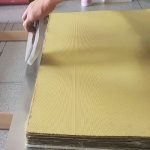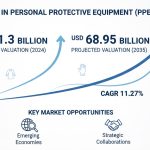The global polystyrene market is undergoing a significant transformation, driven by advancements in production technologies, increasing demand from key end-use industries, and regional shifts in consumption and production patterns. Among these regions, Asia Pacific stands out as the largest and fastest-growing market, driven by rapid industrialization, urbanization, and infrastructure development.
Download a sample PDF 250 Pages of Polystyrene Market Report, published by Vantage Market Research.
Overview of the Polystyrene Market
Polystyrene, a versatile thermoplastic polymer, is widely used in packaging, construction, electronics, and consumer goods. Its lightweight nature, thermal insulation properties, and ease of manufacturing make it a popular choice across various industries. The global polystyrene market is expected to grow at a CAGR of approximately 5.32% from 2023 to 2034, reaching a valuation of billions of dollars.
The Asia Pacific region dominates the global market, accounting for more than 50% of the total demand. Factors such as population growth, rising disposable incomes, and industrial expansion are fueling the demand for polystyrene in this region.

Asia Pacific’s Dominance in the Polystyrene Market
Market Size and Key Drivers
Asia Pacific’s dominance in the polystyrene market is attributed to several key factors:
- Rapid Industrialization: Emerging economies like China, India, and Southeast Asian nations are witnessing robust industrial growth, driving the demand for polystyrene in packaging, construction, and automotive sectors.
- Urbanization: Increasing urban populations are boosting demand for construction materials, including expanded polystyrene (EPS) and extruded polystyrene (XPS), used in insulation and lightweight construction.
- Booming E-commerce: The rise of e-commerce in countries such as China and India has significantly increased the need for protective and lightweight packaging solutions, where polystyrene plays a critical role.
Regional Production Hubs
Asia Pacific is home to some of the world’s largest producers of polystyrene, with countries like China, South Korea, and Japan leading in production capacities. China, in particular, is the global leader in both production and consumption, thanks to its robust manufacturing infrastructure and domestic demand.
Low Manufacturing Costs
The availability of low-cost raw materials and labor in Asia Pacific gives it a competitive edge in polystyrene production. These cost advantages make the region an attractive hub for global manufacturers looking to optimize production costs.
Applications Driving Demand in Asia Pacific
Packaging
Packaging remains the largest application segment for polystyrene in Asia Pacific. Key industries driving this demand include:
- Food and Beverage Packaging: Polystyrene is widely used for food containers, cups, and trays due to its thermal insulation properties and food safety compliance.
- Electronics Packaging: The region’s booming electronics industry relies on EPS foam for protective packaging during transportation.
Construction
The construction sector in Asia Pacific is a major consumer of polystyrene, especially in insulation materials. The increasing adoption of energy-efficient building practices has driven the use of EPS and XPS in thermal insulation applications.
Consumer Goods
Asia Pacific’s growing middle class is fueling demand for consumer goods, many of which incorporate polystyrene components. From household appliances to toys, polystyrene’s versatility makes it indispensable.
Automotive
In the automotive industry, polystyrene is used in lightweight components, contributing to improved fuel efficiency. The expanding automotive markets in China, India, and Southeast Asia are driving this demand.
Challenges and Opportunities in Asia Pacific
Challenges
- Environmental Concerns: Polystyrene faces criticism for its environmental impact, particularly due to its non-biodegradability and challenges in recycling. Governments in Asia Pacific are introducing stricter regulations on single-use plastics, affecting the demand for traditional polystyrene products.
- Volatile Raw Material Prices: Polystyrene is derived from styrene, a petrochemical product. Fluctuations in crude oil prices impact raw material costs, posing a challenge for manufacturers.
- Lack of Recycling Infrastructure: While recycling initiatives are gaining momentum, many developing countries in Asia Pacific still lack the necessary infrastructure for efficient recycling of polystyrene waste.
Opportunities
- Sustainable Alternatives: Innovations in biodegradable polystyrene and advancements in recycling technologies present significant growth opportunities. Companies investing in sustainable solutions can gain a competitive edge in the region.
- Government Support for Green Construction: Policies promoting energy-efficient and eco-friendly building practices are boosting demand for EPS and XPS insulation materials, creating a lucrative market for polystyrene in the construction sector.
- Emerging Markets in Southeast Asia: Countries like Vietnam, Indonesia, and the Philippines are emerging as new growth hubs for polystyrene, driven by rapid economic growth and infrastructure development.
- Circular Economy Initiatives: Collaborative efforts between governments, industries, and non-governmental organizations are driving circular economy models in Asia Pacific, creating a sustainable future for the polystyrene market.
Regional Comparisons: How Asia Pacific Stands Out
North America
While North America focuses on sustainability and recycling, its market size is relatively smaller compared to Asia Pacific. The region’s strict regulations on single-use plastics have driven innovations in recycled polystyrene.
Europe
Europe leads in sustainability practices, with significant investments in circular economy initiatives. However, its market growth is slower due to mature economies and stringent environmental policies.
Asia Pacific
In contrast, Asia Pacific’s rapid industrialization, low production costs, and booming end-use industries position it as the global leader in the polystyrene market.
Middle East & Africa
The Middle East and Africa are emerging markets for polystyrene, primarily driven by construction activities. However, their market share remains small compared to Asia Pacific.
Future Outlook: Growth Opportunities in Asia Pacific by 2034
Innovations in Recycling
Advancements in chemical and mechanical recycling are expected to improve the sustainability of polystyrene in Asia Pacific. Companies like Agilyx and regional initiatives are investing heavily in recycling technologies, offering new growth prospects.
Smart Packaging Solutions
The rise of smart packaging technologies, incorporating sensors and advanced materials, presents opportunities for high-performance polystyrene products tailored to e-commerce and logistics.
Green Building Materials
The increasing emphasis on green building certifications and energy-efficient construction is driving innovation in polystyrene insulation materials. Manufacturers investing in eco-friendly solutions stand to benefit significantly.
Expansion in Rural Markets
Rural markets in countries like India and Indonesia present untapped opportunities for polystyrene applications in packaging and construction. As infrastructure development expands to these areas, demand for lightweight and durable materials like polystyrene will grow.
Access the Full Report Polystyrene Industry Trends and Projections Now
Conclusion
The polystyrene market in Asia Pacific is poised for robust growth, driven by its dominant position in global production and consumption. While challenges such as environmental concerns and volatile raw material prices persist, the region offers unparalleled opportunities for innovation and expansion. With a focus on sustainability, recycling, and new applications, the polystyrene market in Asia Pacific is not only meeting current demands but also shaping the future of packaging, construction, and consumer goods industries.
As global manufacturers and policymakers align their strategies toward a circular economy, Asia Pacific’s leadership in the polystyrene market will continue to solidify. By embracing innovations and sustainable practices, the region is setting the stage for long-term growth and resilience in the polystyrene industry.
Examine the whole Polystyrene Market study by Vantage Market Research for a thorough examination of industry projections, major players, and geographical trends.
![[Market Research Reports] – Research Google News Blog | VMR.Biz](https://www.vmr.biz/wp-content/uploads/2022/12/logo-removebg-preview.png)











